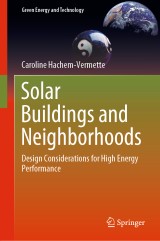Details

Solar Buildings and Neighborhoods
Design Considerations for High Energy PerformanceGreen Energy and Technology
|
CHF 165.50 |
|
| Verlag: | Springer |
| Format: | |
| Veröffentl.: | 30.05.2020 |
| ISBN/EAN: | 9783030470166 |
| Sprache: | englisch |
Dieses eBook enthält ein Wasserzeichen.
Beschreibungen
<div><p>This book presents the main principles for designing buildings and neighborhoods with increased potential to capture and utilize solar energy. It discusses practical issues in the design of the built environment and their impact on energy performance; and a range of design considerations, from building components (e.g. the building envelope) to urban planning issues (e.g. density and street layouts). In addition to design guidelines on how to increase buildings’ potential to capture solar energy, the book provides creative tips to increase the aesthetic value of solar technology integration in buildings.</p>
<p>Helping readers plan energy-efficient buildings with innovative building envelope technologies, and to understand the impact of early-stage design considerations on the energy performance of buildings and communities, the book offers a valuable source of information for building professionals, including architects, engineers, and urban planners. It can also serve as a reference guide for academics and students of energy efficiency in buildings and urban planning.</p><br></div>
<p>Helping readers plan energy-efficient buildings with innovative building envelope technologies, and to understand the impact of early-stage design considerations on the energy performance of buildings and communities, the book offers a valuable source of information for building professionals, including architects, engineers, and urban planners. It can also serve as a reference guide for academics and students of energy efficiency in buildings and urban planning.</p><br></div>
<p>Principles of solar design.- Introduction building envelope.- Selected high-performance building envelopes.- Active solar technologies.- Advanced solar envelope design.- Residential, low-density neighborhoods.</p><p></p>
<div><p>Dr. Caroline Hachem-Vermette is an Associate Professor at the University of Calgary’s Faculty of Environmental Design. An architect by training, she holds a Master’s degree in Architectural Engineering, and another Master degree and a Ph.D. in Building Engineering. Her research interests include assessing the solar potential and energy implications of building shapes, building envelope design, and multifunctional high –energy performance neighborhood patterns, to reach net zero energy status. Her research is multidisciplinary and serves as a “bridge-builder” between building engineering and architectural and urban design. An expert member affiliated with the International Energy Agency’s Task 63 (Solar Neighborhood Planning) and Task 51 (Solar Energy in Urban Planning), she has published in prestigious journals such as the Journal of Applied Energy, the Journal of Solar Energy and Journal of Energy and Buildings. She has been involved in feasibility studies for several solar community designs in regions across Canada. She is a recipient of a number of awards including the 2019 Peak Scholar award, the 2016 Sustainability Award, e-sim/ IBPSA Award for Innovation in Modeling, and Hangai Prize for young researchers.</p><br></div>
<div><p>This book presents the main principles for designing buildings and neighborhoods with increased potential to capture and utilize solar energy. It discusses practical issues in the design of the built environment and their impact on energy performance; and a range of design considerations, from building components (e.g. the building envelope) to urban planning issues (e.g. density and street layouts). In addition to design guidelines on how to increase buildings’ potential to capture solar energy, the book provides creative tips to increase the aesthetic value of solar technology integration in buildings.</p>
<p>Helping readers plan energy-efficient buildings with innovative building envelope technologies, and to understand the impact of early-stage design considerations on the energy performance of buildings and communities, the book offers a valuable source of information for building professionals, including architects, engineers, and urban planners. It can also serve as a reference guide for academics and students of energy efficiency in buildings and urban planning.</p><br></div>
<p>Helping readers plan energy-efficient buildings with innovative building envelope technologies, and to understand the impact of early-stage design considerations on the energy performance of buildings and communities, the book offers a valuable source of information for building professionals, including architects, engineers, and urban planners. It can also serve as a reference guide for academics and students of energy efficiency in buildings and urban planning.</p><br></div>
Provides practical guidelines on how to increase buildings’ potential to capture solar energy Describes tested technologies that will help architects and engineers design buildings for higher energy efficiency Offers architects advice on how to improve the aesthetic appearance of solar technology integrated in buildings
Diese Produkte könnten Sie auch interessieren:

Water Quality Hazards and Dispersion of Pollutants

von: Wlodzimierz Czernuszenko, Pawel Rowinski

CHF 177.00















